

This document is an insertion (of ours) into the series of Phases of hymenopterous evolution as it is proposed by MALYSHEV, 1966. After this insertion we will continue with expounding MALYSHEV's series of Phases, the origin of ants, and, concluding the evolution of the Order Hymenoptera, the origin of bees.
Preadaptations for Sociality
Social life appears in many groups having separate ancestries, indicating that it has arisen many times in the Hymenoptera but only once elsewhere in the insects (the termites). Evidently the higher Hymenoptera are somehow preadapted for social life, and since ants and bees are believed to have been derived from wasplike ancestors, it is possible that the wasps hold the key to an understanding of this problem. It is probable that the haploid-diploid mode of sex determination, which is so characteristic of Hymenoptera, provided one major preadaptation, which we shall explore further later on. Another prerequisite is the possession of a nest, and furthermore of a nest which is dug before provisioning [including hunting] begins and which has several cells which are stocked with numerous prey. It is this facet of the problem that we wish to consider here.
The fact that several groups of wasps (Scolioidea, Pompilidae) do not build nest-cells to which they return repeatedly helps explain why none of them have become social. Yet in a measure they may suggest evolutionary stages through which the social wasps may once have passed. A brief summary of the apparent major steps in the evolution of nesting behavior of solitary wasps may assist in an understanding of the origin of sociality. These steps are progressive in the sense that they must occur in approximately this order and that they lead from simple to more complex behavior. They may be thought of as "rungs in the social ladder" in the sense that the social wasps must once have "climbed" them. See next Figure.
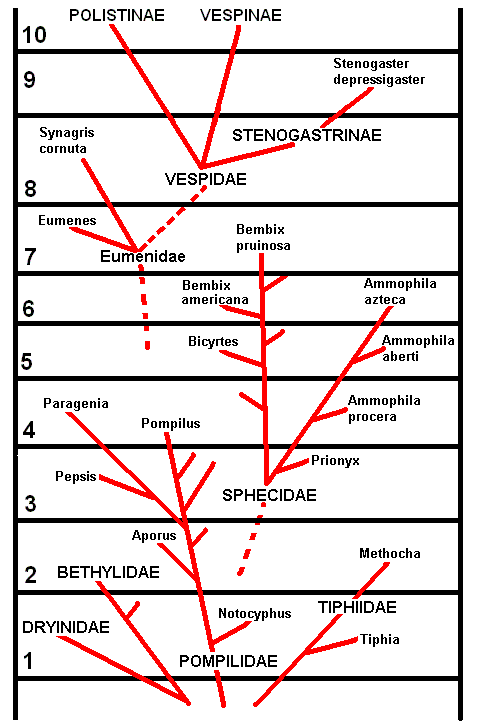
Figure 1 : The "social ladder". Only a few genera or higher taxa representative of each step are shown. See text for meaning of numbers of each step.
(After EVANS and EBERHARD, 1973)
But of course each rung must have its own adaptive value [meaning that they are perfect strategies of their own], since many wasps inhabit each rung successfully and the evolution of sociality was by no means preordained.
EVANS and EBERHARD now, pp. 115, expound all these preadaptive steps (represented by the rungs of the "social ladder"). Because these proposed steps are more or less similar to the "phases" of MALYSHEV so far, we will not give them here in full, but only their captions. Like in MALYSHEV, each one indicates the consecutive order of the individual acts of nest preparing etc. of the mother wasp.
A "niche" here means a burrow. A letter n (or x) following an act placed in square brackets means an n-fold (or x-fold) repetition of that act.
1. Prey-egg.
2. Prey-niche-egg-(closure).
3. Prey-nest-egg-closure.
4a. Nest-prey- egg-closure.
4b. Nest-prey-egg-[cell closed and new cell prepared-prey-egg]n-closure.
5a. Nest-prey-egg-[prey]n-closure.
5b. Nest-prey-egg-[prey]n-[cell closed and new cell prepared-prey-egg-[prey]n]n-closure.
5c. Nest-[prey]n-egg-[cell closed and new cell prepared-[prey]n-egg]n-closure.
6a. Nest-prey-egg-[prey]x-closure.
6b. Nest-prey-egg-[prey]x-[cell closed and new cell dug-prey-egg-[prey]x]n-closure.
7a. Nest-egg-[prey]x-closure.
7b. Nest-egg-[prey]n-[cell closed and new cell prepared-egg-[prey]n]n-closure.
8. Prey maceration.
9. Prey maceration combined with communal nesting, each female laying eggs and caring for her own larvae.
10. Females supply food in accordance with stimuli received from the larvae and may feed larvae other than their own. Once this had occurred, natural selection tended to produce a familial society in which the most capable egg-layers became established as "queens" and others as "workers".
These are the preadaptations eventually leading to social behavior in wasps.
Social paper wasps : P o l i s t e s
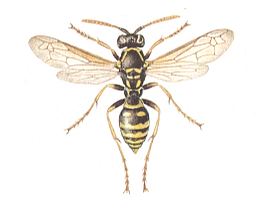
Figure 2 : Polistes nimpha. 12-12.5 mm. Vespidae.
(After SEVERA, in ZAHRADNIK, Thieme's insektengids voor West- en Midden-Europa, 1977)
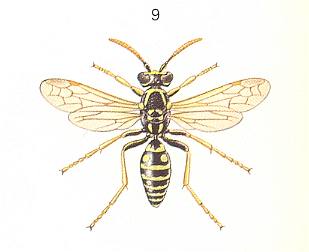
Figure 2a : Polistes gallicus L. ca. 15 mm. Vespidae.
(After CHINERY, in Elseviers insektengids voor West-Europa, 1983)
The paper wasps (Vespidae) are divided into three subfamilies : The Stenogastrinae, subsocial wasps found in the Orient and Australia, the cosmopolitan Polistinae, and the Vespinae (yellow jackets and hornets). The most studied paper wasps belong to the genus Polistes of the Polistinae, for these wasps build easily observed nests having a single comb of hexagonal cells without an envelope -- the small paper nests commonly found in barns and garages and beneath the eaves of houses. A great variety of activities and interactions take place in plain view on the tiny stage that is a Polistes nest. And the colony rarely contains more than two hundred adults, so that it is sometimes possible to follow the movements of all the inhabitants simultaneously. This visibility, and the fact that the range of temperate zone Polistes happens to overlap that of university biologists, helps to explain why the biology of Polistes is relatively well known. We shall use this genus to illustrate the way of life of the paper wasps.
Colony Founding and Queen Determination
In the temperate climate of Europe and North America, Polistes colonies are founded in the spring by fertilized, overwintered females. These "foundresses" are the late-summer daughters of the previous year's queens. They have mated in autumn, then hibernated in groups or alone, secreting themselves in cracks and crevices of old logs, attics, and barns. Males never survive the winter, but their gametes do, in the form of a tightly packed bolus of dormant sperm stored in the spermatheca, or sperm sac, of the overwintering female. This intricate little structure -- a pearly sphere only a quarter of a millimeter in diameter, equipped with various glands and valves whose precise functions have never been investigated -- releases newly activated sperm each time an egg is laid. A Polistes queen thus has a constant supply of sperm without repeated matings.
A Polistes nest begins as a nondescript dab of pulp smeared by an egg-bearing female wasp beneath some horizontal surface. Near the center of this initial dab, pulp is eventually extended into a small stalactite, forming the stem, or pedicel, from which the nest will hang. When this stem is about a centimeter long the tip is broadened into a shallow cup -- the first cell. Thus it is always possible to identify the oldest cell in a nest by finding the one attached to the original pedicel. Soon other cells are added. But first the female lays an egg in the new cell. This is the rule usually followed throughout the life of the colony : eggs are laid one per cell, and new cells are initiated only when there are no empty cells present. With the laying of the first egg the female is officially a queen -- an egg-laying nest resident.
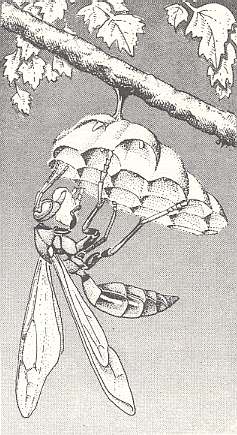
Figure 3 : Foundress queen (Polistes annularis) on a young nest. In her mandibles she carries the flesh of a caterpillar to be masticated and fed to the larvae.
(After EVANS and EBERHARD, 1973)
In some Polistes species the nest initiator is the only female present until the colony offspring begin to emerge. But in other species there are sometimes from two to ten such foundresses. Only one of the associated females will ultimately be a queen. The others, although fertilized, usually become workers which help raise the queen's young. Observations of marked wasps indicate that co-foundresses of a nest are often sisters. In tropical populations which nest year-around, sisters simply move from a declining colony to a newly founded one nearby. In the temperate zone females evidently remember the site of their parental nest and return to it after hibernation. The significance of sibling cooperation for the evolution of social life will be discussed below.
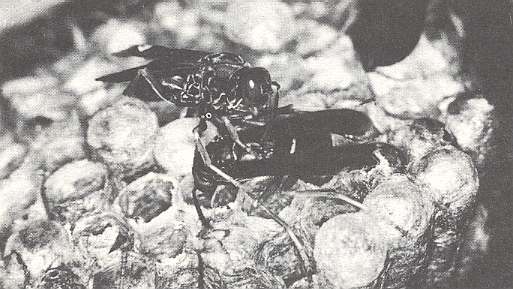
Figure 4 : Dominance and subordinance in Polistes fuscatus. The female on the left has the relatively elevated posture characteristic of a dominant individual as she aggressively bites a leg of a motionless, crouching subordinate (right). (After EVANS and EBERHARD, 1973)
Pardi noticed that the foundress queen was always the alpha, or most dominant, female in the hierarchy formed on a new nest. And when he dissected females of known rank in hierarchies he found a correlation between ovary size and social rank. In a hierarchy of three, for example, the alpha, beta, and gamma females ranked one, two, and three in order of decreasing ovary size. Furthermore, the longer they lived together the more pronounced the internal difference became. Pardi hypothesized that this was due to another of the important facts he observed about dominance-subordinate behavior, namely, that dominant individuals are able to command solid food, regurgitated nectar, and pulp from subordinates. This would conserve the energy of a dominant female by making it unnecessary for her to leave the nest to obtain food and building materials, while costing the subordinates energy in replacing loads given up. Presumably these nutritional differences would affect the amounts of energy available for egg production, and hence would enhance differences in ovary size. And, assuming that the dominance differences are causally linked to the ovary differences, the larger ovaries would in turn be accompanied by greater dominance. All of this being the case, dominance relations would play a role in queen determination along with differential egg eating.
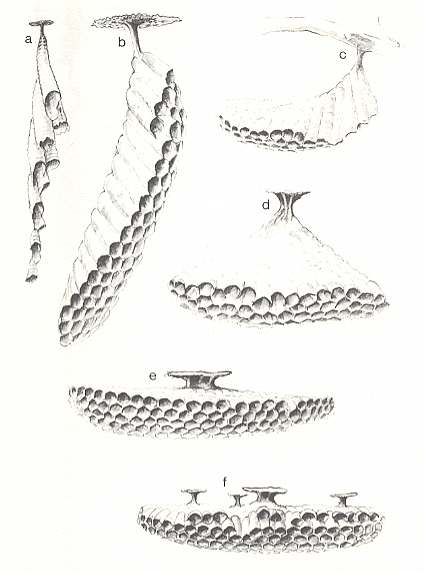
Figure 5 : Nests of Polistes species, showing differences in the number and placement of pedicels and in shape of the comb.
a - P. goeldii. b - P. canadensis infuscatus. c - P. annularis. d - P. major. e - P. flavus. f - P. fuscatus.
(After EVANS and EBERHARD, 1973)
Development of the Eggs and Larvae
In contrast to the honeybee hive, in which certain cells contain brood and certain others are reserved for storage of honey and pollen, all of the cells in a Polistes nest are primarily brood cells. The egg is cemented in each new cell usually to the cell wall nearest the nest center, where it points toward the center of the cell. The transformation to larva occurs in about two weeks in the temperate zone and is barely discernible when the egg's free tip acquires motility and a mouth. The Polistes larva is little more than a sac for processing food. Not surprisingly, most of its behavioral responses have to do with food. It is unable to get out of its cell or even to turn around within it, but it can extend its head a few millimeters over the edge. This movement has become involved in a simple communication system between larvae and adults. When a female is dispensing solid food or nectar to larvae, she often finds them with bodies compressed and head retracted into the cell. She pauses at the mouth of the cell and signals her presence by rapidly knocking her head against the edge, the resulting vibration of the nest producing a brief buzz audible to the human ear. The larva responds by extending its body, bringing its mouth clear of the cell's edge. The adult then feeds the larva by thrusting material against its face or, in the case of nectar, touching the larva's mouthparts with its own. The larva, in turn, reacts by exuding a drop of saliva and moving its mouthparts. In the transfer of solid food it is the larva that is then most active. It bites and tugs at the load held firmly by the adult until a morsel pulls free, then ingests it while the adult attends others.
The larval feeding reflexes are easy to elicit artificially. If the wall of a larva's cell is pricked sharply with a pin in imitation of head knocking, the larva protrudes its head. And if its mouthparts are then gently poked with the head of a pin a drop of clear fluid soon appears at the larva's mouth. The adults frequently move from cell to cell giving the feeding signals, then imbibing the drops of fluid thus elicited from the larvae -- without giving any food in return. This interaction is the subject of one of those gentle controversies that make academic life interesting, while seldom causing any loss of life or limb. The first to observe the transfer of larval fluid was the French naturalist Etienne Roubaud, who described it in 1916 in a classic paper on African wasps. Roubaud, like some recent observers, had the impression that the adults avidly solicited the droplets, and considered the exchange of materials between adults and larvae a vital factor in the evolution of social life. This idea was given wide publicity later by the famed entomologist William Morton Wheeler, whose 1923 book Social Life among the insects was for many years a standard in the field.
Even with this focusing on "trophallaxis", as such chemical communication came to be called, the role of the larval fluid in wasp social life is not understood. In 1952 M.V. and A.D. Brian studied the fluid secreted by larvae of Vespula sylvestris, a social vespid having Polistes-like larvae with a secretion solicited by the adults as in Polistes. They gathered samples of larval fluid and offered them to adults along with water and various kinds of sugar solutions and reported that the adults were not any more attracted to the larval fluid than they were to plain water. They suggested that the fluid may not be so much a social bond between adults and young as a means of excretion for a larva lacking a hindgut. However, chemical analysis has revealed that the fluid contains little in the way of nitrogenous wastes. And some as yet inconclusive studies suggest the presence of enzymes not produced by the adults but needed by them. So the controversy rages on, but one thing is certain : trophallaxis should not be considered in any sense a "prerequisite" for insect sociality, as the earlier workers implied. For some social insects -- the stingless meliponine bees -- manage their social lives without any larva-adult interaction, sealing the egg and a food supply in a waxen cell that remains closed until the young bee matures [So trophallaxis is not indispensable for sociality -- is not a necessary and integral part among the parts that together make up sociality -- , but may have been indispensable at the very origin of sociality, and later, in some groups abolished]. In temperate-zone Polistes the larval stage lasts, on an average, about 15 days. Its end is signalled by the appearance of a gleaming white silken cap over the cell, spun by the larva itself before pupation. See next Figure.
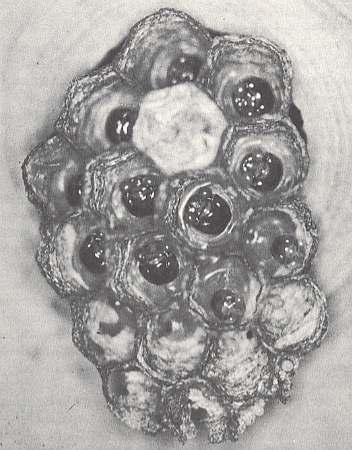
Figure 6 : Immature Polistes wasps (P. canadensis). Shallow peripheral cells (bottom) contain eggs. Deeper central cells contain larvae. The white-capped cell contains a pupa whose silken cocoon (spun by the mature larva just before pupation) lines and closes its cell.
(After EVANS and EBERHARD, 1973)
The cell then becomes a cocoon where the wasp undergoes the transformation from grublike larva to winged adult. After about twenty-two days inside the capped cell, a fully pigmented adult emerges.
Behavior of Adult Females
For two to five days after emerging, the young adult does little except groom (preening is a frequent activity of all adult Polistes), buzz its wings, and solicit an occasional mouthful of food from other adults. Then, or perhaps earlier -- the mechanism is still a mystery -- an important decision is made regarding a female's role in the colony (we shall deal with males later). As we have already seen, there are two behavioral castes in Polistes : The workers, which forage but generally do not lay eggs, and the queens, which lay eggs and do little foraging. Corresponding to these castes there are two behavioral categories among the young females emerging on the nest. Some begin to forage after the brief callow period and are workers as long as they remain on the nest. Others remain lethargic and idle like the newly emerged ones, grooming and soliciting food, but spending most of the day and night crouched out of sight on top of the nest. They seldom leave the nest and never return with food, water, or pulp. Nor do they participate in the distribution of these materials to other individuals. Some of these non-workers are destined to be queens.
Technically, all a Polistes female has to do to be called a queen is lay eggs. Sometimes -- when an established queen dies or disappears from the nest -- a worker begins to oviposit. And, as already pointed out, subordinate foundresses may lay eggs during the period of queen determination. However, reproduction of such temporary queens is probably negligible : workers seldom get a chance to lay eggs until the end of the season, when there is insufficient time for their offspring to mature. Even then they can produce only males, as they have not mated (even workers on nests with males for some reason do not mate). And most of the few eggs laid by subordinate foundresses are devoured by competitors. So the only queens of consequence are the alpha foundresses -- the females who manage to dominate their companions on new nests and become the biological mothers of the next generation.
Becoming dominant in a group of foundresses is only the last in a whole series of trials leading to the queenship. Not the least of these for a temperate-zone wasp is making it through the winter. And to produce female offspring she must have mated the previous autumn. The non-workers have a number of advantages over workers in this competition for reproductive rights. Their relative inactivity means that they are able to store energy rather than consuming it in foraging and brood care. But probably even more important is the fact that the non-workers emerge late in the summer, whereas the workers are the first born of the colony offspring. Females emerging toward the end of the summer are more likely to persist until the autumn mating season, and are more likely to live through the winter. Furthermore, they tend to be better nourished and larger, as there is a gradual seasonal increase in the food available to larvae (due to a general rise in the worker-larva ratio, and [a rise] in the proportion of food in foraged loads [that is, proportionally increased amount of food as compared to building material] ). So the idle female offspring have been called fondatrices-filles -- foundress daughters -- in recognition of their enhanced likelihood of appearing on new nests the following spring. The behavior of these wasp ladies-in-waiting on the parental nest is a dull contrast to the bustling activity of their worker sisters.
In a typical day, an ordinary worker on a midsummer's nest in a midwestern [USA] barn makes about twenty foraging flights. When she is young she memorizes the location of her nest, circling and dipping about it, often hovering in a prolonged buzzing stare at a particular rafter or a conspicuous knothole. Inexperienced wasps who are prevented from doing this (for example, by being experimentally chased from the nest before their first flight) seldom make it back. And one of the hazards of artificially transplanting colonies is that some foragers fly off without executing these orientation flights [because they have already done so at the previous location of the nest], then never return, as they have the wrong set of homing cues. On the other hand, transplanted individuals who circle before leaving usually return home.
Polistes wasps forage for four different kinds of things : fiber for use in making pulp, proteinaceous food, usually in the form of insect larvae, nectar, and water. The females never collect and transport pollen. Hunting wasps are innocuous, preoccupied creatures, about as likely to attack a human being as they are to sting a bush or a tree trunk. When near the feeding places of caterpillars, Polistes females climb in a frenzy up and down branches or grass stems, often retracing their steps and seeming to leave no place unexplored. When they encounter prey they seize it immediately with their mandibles and, if the prey is small, fly off with it almost before a human observer notices the capture. Polistes wasps do not sting their prey unless threatened by it, as, for example, by the violent writhings of a large caterpillar. Instead they process it alive, chewing transportable chunks from large prey, and simply carrying off smaller captives. Upon arrival at the nest, food masses are held by the front pair of legs and masticated for several minutes. During this process the mass of food appears to get smaller, either through compression or because the adult ingests a portion. Eventually one edge is pulled almost free of the load and thrust at the face of a larva. Usually, as explained above, the larva itself tugs this bite-sized piece away. But if the larva is unresponsive a worker sometimes pushes a load so forcefully that a bit of moist food adheres to the recalcitrant larva's face.
Returning foragers are frequently met upon landing by one or more of their adult nestmates, who chew simultaneously at the load until it separates into two or more chunks, which are then masticated and either ingested, shared with other adults, or fed to larvae. Foragers seldom resist such sharing, and a single foraged load may be divided among as many as seven adults. Pulp loads are never divided into several portions in this way, although they are sometimes solicited and transferred. Perhaps this is due to the advantage of adding a pulp load in an unbroken (hence stronger) piece. Or perhaps it is simply because pulp is, after all, rather a bland stuff to chew on.
On hot days many foraging trips are devoted exclusively to water collection. Droplets of water appear here and there on the nest and inside cells and some of the wasps sitting on the nest can be seen fanning their wings for minutes at a time. The combination of moistened nest surface and fanned breezes makes an effective evaporative cooling system, with a demonstrated ability to lower the nest temperature and, presumably, keep the brood from overheating. Even males and non-worker females, which ordinarily contribute little to the general welfare of the community, participate in the regulation of nest temperature by fanning.
Social insects have somehow gained the reputation of having highly organized, almost mechanically efficient communities. But years of scrutiny by highly trained and sometimes ingenious scientists have failed to reveal precisely how the insects manage to assure all chores being done at all times. In honeybees some light is shed on the matter by the finding that younger workers tend to labor in the hive whereas older ones forage. But no such relationship of age and duties performed can be shown in Polistes. Instead these paper wasps are noted individualists. One of the first biologists to observe the division of labor in Polistes was the gifted part-time naturalist Phil Rau. Rau marked individual wasps with paint and recorded their activities, referring to them by what he called "Indian names" suggested by their marks. In Rau's observation colonies "blue dot" specialized in caterpillar hunting, and "white abdomen" was a water carrier. Certain marked workers are relatively aggressive, hence are more often involved in nest defence. But the roles of individuals change from day to day with no apparent regularity.[So the division of labor is present in the colony, but is not permanently anchored in definite individuals. So these individuals, that is, all individuals, except males and non-worker females, remain less dependent on others, meaning that they are less integrated in the colony. Things are different in especially ants and termites, where certain tasks are assigned to certain individuals, especially equipped for them.].
INTERMEZZO : Noëtic Theory
In the context of our general noëtic theory of evolution the evolutionary transition from one group of organisms to another takes place, not in the Explicate, but in the Implicate Order (or, perhaps better, via the Implicate Order). It consists of the formal derivation of one strategy -- present as noëtic pattern -- to another that is more intrinsically noëtically stable, which boils down to the transition from a less internally integrated strategy -- and thus from a noëtic pattern with parts that are in a lesser degree integrated into the whole pattern (the strategy) -- to a strategy that is in a higher degree internally integrated.
Normally, a strategy is a noëtic pattern (a pure form), a strategy, that is, for that very strategy to exist in the Explicate Order -- and so obtaining ontological completion (a pure 'naked' Form becomes received by Prime Matter [the latter becoming informed], resulting in a physical material thing or dynamical system). Upon projection into the Explicate Order it consists of physical material individuals of, first of all, a given biological species, of individuals, that is, having the morphology, biochemistry (such as the genome and its operation), physiology (functions of organs), and behavior of that species. These individuals are space-time objects, living during a certain period of time at certain localities. They are physically separated entities, or, as we may call them, physically separated dynamical systems. Each such a system goes through a succession of dynamical states, not only, as in holometabolic insects, including the egg, larval, pupal, and adult states, but also, in each of these chief states going through a number of sub-states. And in wasps the most significant of such sub-states are those of the adult state, and, when a female, especially its successive instinctive activities (feeding, nest building, oviposition, foraging, nursing, etc.). In this way, at least in solitary wasps (and most other animals for that matter) each individual, with all of its morphology, biochemistry, physiology, and behavior, completely represents the strategy of the species. Not so in social organisms. There, especially in social insects, the individual does not represent the complete strategy of the species, but only a part of it. Only each individual c o l o n y (society) as a whole does represent the complete strategy of the species (to which these individuals belong). The colony is now an 'individual' of the species. And this (super)individual can execute several different function at the same time : While guarding the nest, it at the same time forages, and at the same time nurses the larvae, etc. [but not, however, increasing the number of (successful) offspring per physical individual because they themselves are (with) many also]. So here (in social insects) the integration of parts -- originally being the material and behavioral parts of the individual physical organism representing the species --, and thus the internal integration of the strategy, has moved one step up : It has moved from the level of the physical individual to the level of the colony. Now, the existing separate colonies are the true "individuals" of the species. And now they represent the whole strategy of that species. In such a colony the physical individuals have lost their independence, they are now dependant upon the other individuals of such a colony, meaning that they, as parts, are integrated into the whole of the colony. So the integration of the strategy has now moved from physical individuals to the colony as a whole, meaning a significant increase of the degree of internal integration of the strategy.
Back in the Implicate Order this means an increase of the degree of intrinsic noëtic stability, and thus a possible formal derivation of such a strategy from one having a lower stability (in the Explicate Order represented by a solitary biological species).
We must realize that in spite of the mentioned increase in the degree of integration in social insects the state of being social is not necessarily ecologically better. It is just another strategy, a strategy that is, for the correwsponding noëtic pattern, noëtic strategy, to exist and persist in the Explicate Order.
Above we have seen that in Polistes this shift of integration of the strategy from the level of the physical individual to that of the colony as a whole, is only partly accomplished : the physical individuals still have a fairly high degree of individuality, thus being not completely integrated into te colony. But they, nevertheless, have lost some of their independency (as solitary wasps have it) and thus are in a certain degree integrated into the colony. The shift of integration of the strategy from the physical individual to the colony is here, that is in Polistes, evolutionarily, on its way to more completion. In the Explicate Order we see this shift of integration being accomplished by the development of a communication system between the physical individuals of a colony by means of signals of various kinds. So the bonds between the physical individuals making up the colony are formed by signals between them. Probably the most important of these are the dominance-subordinate signals among physical individuals of a given colony. But also other kinds of signals play a role in the integration of parts of the colony, and thus in the internal integration of it.
(End of Intermezzo)
Like Darwin and Freud, the social insects have contributed to the disillusionment of man. For we now know that these "lower animals" communicate with each other, even exchanging information about such subtle things as the nature and location of food sources, thus claiming for themselves a capacity formerly considered uniquely human.
The Colony Cycle
A Polistes nest and the composition of the wasp population inhabiting it is always changing. In fact, a temperate-zone wasps' nest is a kind of calender by which you can gauge the progress of the summer [We can see the dynamical system "colony" going through a succession of dynamical states, just like each one of its physical individuals do]. Since old nests are rarely reused, inhabited nests in springtime are small and have shallow cells attended by one or a few females, the colony foundresses. In late spring and early summer there is a hub of bright-capped pupal cells in the center of the nest, which as they age become dark with lines of pulp spread across them by the adults. Soon the first offspring -- almost invariably females -- emerge from the capped central cells, and eggs take their places, leaving a ring of cocoons [capped cells] which gets further and further from the nest center as successively later young mature. The first twenty or thirty offspring to emerge are workers, that is, females who forage and care for the brood. Then the non-worker females and the males emerge, producing by late summer a large adult population composed mostly of future reproductives, which spend their days sitting, grooming, and soliciting food from returning foragers. In late summer, well before the onset of cold weather, the queen stops laying eggs and adds no new cells to the nest. But brood care proceeds as before and the adult population continues to grow as more offspring emerge.
With the cessation of egg laying the colony begins to show signs of decline. Cells from which brood has emerged or in which eggs or larvae have died are not oviposited in, and as a result there is an increasing number of empty cells. Late in the nesting season there is commonly some cannibalism of the brood by adults. Larvae and sometimes even pupae are pulled from the cells, then divided and fed to living larvae like foraged food loads. It has been suggested that this behavior may increase the number of young reaching adulthood by concentrating the dwindling resources of the colony in a few individuals.
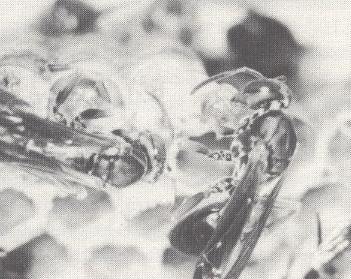
Figure 7 : Cannibalization of the brood (Polistes fuscatus). A worker (right) first chewed away the cap of a pupal cell, extracted the young pupa as shown, and ate it, sharing the meat with other females and larvae. (After EVANS and EBERHARD, 1973)
The scarcity of food is reflected in the behavior of wasps on the nest toward returning foragers : food-laden workers are solicited from with increasing vigor and are sometimes mobbed by seven or eight nestmates, all pulling at once at the bits of food held by the foragers' mouthparts. Even unladen returnees are met by solicitors.
Mating and Hibernation
The males' primary reason to be is sex. Even while on the nest they mount and attempt indiscriminately to copulate with individuals of both sexes. However most, if not all, successful mating activity takes place after the abandonment of the parental nest. Characteristically the males station themselves at a place frequented by females. Phil Rau observed a group of P. rubiginosus males attempting copulation with females emerging from a crevice which presumably led to a cavity containing a nest and was also a hibernation site. Males of P. canadensis in tropical Colombia have been observed in pursuit of females flying in and out of an abandoned coal mine containing numerous newly founded nests. And in P. fuscatus, the common brown paper wasp of North America, males sit near the entrances to hibernation places and pounce on the females as they enter. On sunny autumn days large numbers of this species sometimes gather, commonly flying about high sunlit structures near hibernation sites. These "swarms" of wasps look quite menacing. The males circle and dive as if attacking and pairs of waps fall grappling to the ground. The mating wasps evidently remain coupled for only a few seconds at most. And they are in such active motion that it is impossible to observe the details of mating behavior or, in most cases, even to ascertain if copulation is complete. However, sexually responsive males, identifiable by their head-tilting alertness and their location near hibernicula [a hibernaculum is a cavity or enclosure serving as a hibernation place], will copulate with females partially immobilized as shown in the next Figure, so it has been possible to photograph the movements involved in mating.
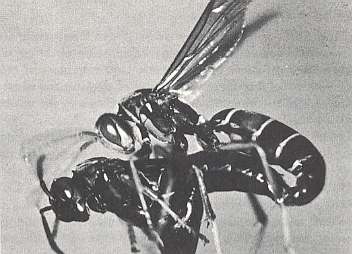
Figure 8 : Copulation of a male (above) and a partially immobilized female (Polistes fuscatus). During copulation the male's antennae beat rapidly against those of the female.
(After EVANS and EBERHARD, 1973)
Motion pictures indicate that the copulating male vibrates his antennae very rapidly against those of the female, and at one point uses the curled tips of his antennae to lift or stroke the female's antennae. Thus the antennae of Polistes males are morphologically and functionally reminiscent of those of certain male potter wasps [Eumenidae]. The latter are solitary relatives of the vespids in which the males of some species have sturdy hinged hooks at the extremities of their antennae which firmly grasp the antennae of the female during mating. The photographs also reveal that when the male genitalia are inserted the female's sting is extruded as it is, incidentally, when the genital orifice is open during egg-laying. Thus the attacklike courtship behavior of the Polistes male may be just that -- an assault serving to elicit aggression and stinging by the female, thus moving the sting apparatus clear of the genital opening and making it possible for the male to insert his genitalia.
Having, with all this, presented an instructive example of social life in wasps, it is now time to investigate its origin, not only in Polistes (or Polistinae for that matter), but in all social wasps (Vespidae).
The Evolution of Social Behavior in Wasps
The present section will be about why and how true social behavior (division of labor) in wasps has originated (according to EVANS and EBERHARD 1973), and the question whether such an origin demands necessary -- sine qua non -- conditions, and if so what these conditions are. And do there exist in certain solitary wasps structures, features, habits, etc. that are, it is true, not indispensable for sociality to originate, but nevertheless strongly support the evolutionary transformation from a solitary to a social way of life?
Before we enter these questions we first present some photographs concerning some social wasps other than Polistes.
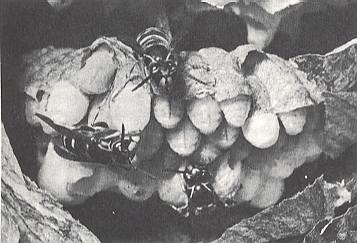
Figure 9 : Adults and comb of Vespa saxonica. The nest envelope has been partially removed. Grublike larvae protrude from the cells.
(Photograph by László Móczár, in EVANS and EBERHARD, 1973)
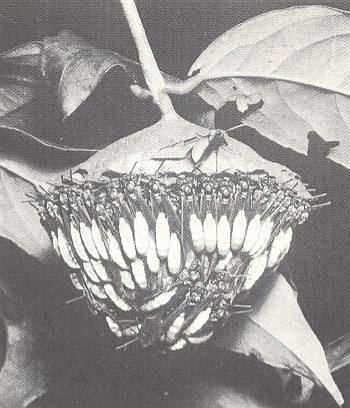
Figure 10 : A colony of the nocturnal wasp, Apoica pallens, resting in daytime. Note the defensive alignment of wasps at the nest periphery.
(Photograph by W.D. Hamilton, in EVANS and EBERHARD, 1973)
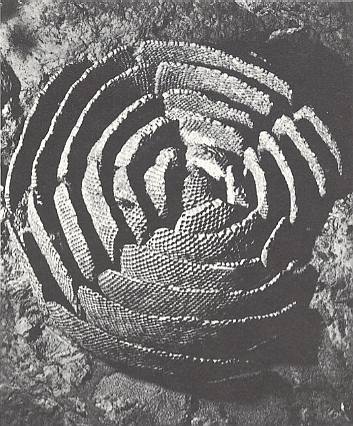
Figure 11 : Nest of a species of Stelopolybia. This extraordinary type of nest, having nearly spherical concentric combs, was unknown until 1969, when William Hamilton carefully excavated and photographed this specimen in Brazil.
(After EVANS and EBERHARD, 1973)
We left the solitary wasps in the previous document (where we finally arrived at the social wasps). Those solitary wasps which are at the brink of sociality had nesting behavior with features in common with all social vespids : progressive feeding of the larvae, relatively long-lived mothers staying with their young, and nests containing several young wasps of various ages at one time. Some of these [still solitary] wasps nest communally, with each female of a nesting aggregation caring for her own young. But none of them had a reproductive division of labor of the kind we have just described as being characteristic of the social wasps.
INTERMEZZO on genetics and noëtics
Natural selection, in the Neo-Darwinian sense, is about the abundance of genes or gene combinations in a given population, and thus about the abundance of their bearers. It is in fact a tautology : the more individuals having a certain gene or gene combination survive, the more of such individuals we will have in the next generation. Or, said differently, the greater the success of particular individuals as a result of their having a particular gene or gene combination (as a result of some genetic mutation), the more of them will reach reproductive maturity, the more of them will then reproduce, and the more offspring there will be having [inherited] that particular gene or gene combination, and, finally, the more abundant this gene or gene combination will be in the population. This population is then becoming genetically different from other populations (where the mentioned genetic mutation did not take place) of the same species, eventually leading to the division of this species into two daughter species. So natural selection is only about reproductive success and [thus] number of offspring, and is not directly about things like "higher development" (anagenesis, integration) as we see it in long-term evolution. In the modern Neo-Darwinian theory of evolution it is supposed that all biological adaptations, including those that are associated with social life, are, each one of them, the result of a long chain of successive random (!) genetic mutations. Although most genetic mutations either have no [phenotypic] effect at all or are detrimental, the genetic mutations of the mentioned chain must have been each for themselves more favorable -- and that is, effecting a higher number of offspring -- than the original gene or gene combination was. Taking also into account that genes are highly integrated in the genome of a given animal, the occurrence of such a chain of successive 'lucky' genetic mutations is, according to me, extremely improbable.
The social wasps are supposed to have evolved from solitary wasps. But there is no sign of improved reproduction (resulting in more offspring) in social wasps as compared to that in solitary wasps. And because natural selection is about the number of offspring -- the absolute number of offspring reaching reproductive maturity of the total of individuals of the new population, as compared to the absolute number of offspring of the total individuals of the original population -- we would expect a greater reproductive effect in social wasps, greater that is, as in solitary wasps. But nothing of the kind we see there. Although in the neighborhood of a nest of a social wasp the latter are abundant, they are not significantly so in other locations. And if we connect l a r g e r populations of a given initial species with future increasing evolutionary diversity (of the many new species) originating from such a species, it is significant to note that the largest wasp family is the Sphecidae, digger wasps, which are solitarily living creatures.
A gene, or gene combination, (say) B, resulting from some random genetic mutation of a gene, or gene combination A, in a given interbreeding population of individuals of a given species, that is responsible for [i.e. effects] a larger offspring will automatically become more abundant in the interbreeding population than will be the gene, or gene combination, A. But such a (random) genetic mutation from A to B might eliminate effects of A that enhance certain pre-adaptations that might be advantageous later in evolution. Genes, or gene combinations, are, as has been said, not independent units in the genome [the complete set of genes of an individual organism] but are interconnected with other genes in the genome, that is, they are functionally integrated in the genome as a whole. Such a pre-adaptation (whereto gene A might lead) might well be one of the necessary pre-adaptations to future social life. So the direct action, or better, effect, of natural selection -- here the gene, or gene combination, B becoming more abundant in the population, and eventually replacing gene, or gene combination, A -- is then not in itself promoting the origin of social behavior.
It is clear that the Neo-Darwinian theory of evolution, at least the long-term evolution, based on random mutation and natural selection, leads us nowhere. And because this theory is, as far as we can see, the only theory that makes at least some sense if we would admit the generally accepted view of there existing only one single order of Reality, the Explicate Order (i.e. physical-chemical-biological material Order), we are forced to assume the existence of yet another order. And this order we have called the Implicate or Noëtic Order. And all evolutionary transformations, as apparently seen in the Explicate Order, take place via the Implicate Order in the way described earlier.
(End of Intermezzo)
Before we continue with presenting the views of EVANS and EBERHARD on the evolutionary origin of sociality in wasps, we repeat some statements of them (and comments added), already given (by us) just before the INTERMEZZO :
. . . that animals can be expected to help other individuals, even at cost to themselves, providing those individuals are closely enough related to them. This is because relatives have a similar hereditary makeup, so that helping a relative is to a certain extent like helping oneself [This is in itself true, but cannot of course represent a motivation of a given animal individual to help some other individual]. Furthermore, the closer the relative the greater should be the selective advantage in giving him aid [The selection is here the choice who to help : -- A (a daughter, say) helping B (the daughter's mother, say) has selective advantage over A helping C (the daughter's own offspring, say), where "selective advantage" refers to natural selection in the Darwinian sense. When B is genetically more similar to A than is C, then A helping B not only helps to perpetuate B's genes but also (many of) the genes of A itself]. It is most profitable for most animals to care for their own offspring, since these are the closest relatives among the younger generation. However, in the Hymenoptera this is not so, for reasons we shall discuss below.
The statement "helping a relative is to a certain extent like helping oneself " is in itself true, if a certain shared gene or gene combination is to be perpetuated. If such a gene or gene combination is phenotypically expressed as the instinct (of its bearer) to help its closest relatives -- for example defend or nurse its offspring -- then there will be more of such offspring, and thus also a greater number of individuals that have inherited the mentioned gene or gene complex. All this is no more than just a tautology. Although in most animals the "closest relatives" of some given individual are its own offspring, in the Order Hymenoptera this is not necessarily so : We will see that in that Order sisters are more closely genetically related to each other than are mothers to daughters (or sons for that matter). So for a daughter to help her mother in rearing additional daughters, and thus additional sisters (this is what workers in a wasp colony actually do), is for such a daughter to nurse here closest relatives. Here we can thus speak of natural selection (deciding) between (a) a (genetically determined) instinct to nurse (exclusively) own offspring, or (b) (a genetically determined instinct) to nurse (not own offspring but exclusively) mother's (further) offspring. And, logically, between these two genetical alternatives, natural selection will favor precisely that gene or gene complex which will constantly effect a larger number of offspring (reaching reproductive maturity and having inherited that gene or gene complex), larger, that is, than does (effect) the other genetic alternative. Among insects, only in Hymenoptera (all of them) we have these two alternatives (to nurse own offspring, to nurse mother's offspring), because in all other insects, and most other animals for that matter, the closest relatives of a given individual are always its own offspring, and caring for them is the only option to it because others are too different from it). And in most Hymenoptera the care is of own offspring, namely choosing the right oviposition site most appropriate to the own larvae to serve as nutritive substrate, as in saw-flies and parasitic Hymenoptera (terebrantia), or protecting, provisioning and nursing own offspring, as in all solitary wasps. Only in the vespidae (and ants and bees) we see the phenomenon of nursing, not of own offspring, but of that of someone else. This is what all sterile female workers do in social Hymenoptera. It is, however, not clear why and how the instinct to nurse sisters instead of daughters is, in the cases of social Hymenoptera, selected (by natural selection) in favor of the instinct to nurse only own offspring, because the social hymenoptera do not markedly outnumber (in individuals and species) the solitary ones, which should be the result of such a selection.
Further, although we can well imagine the existence, in an individual female, of a genetically determined preference to nurse its own offspring, it is hard to imagine the existence of a gene or gene complex phenotypically effecting a preference in female individuals, carrying this gene, to nurse not their own offspring but their mother's (we cannot always simply maintain that there is "a gene for this, or a gene for that"). Such a gene or gene complex, if it exists, can be truly subjected to natural selection because it is either in all probability transmitted to the own offspring, resulting in individuals with the same preference as to what to nurse, or be present in close relatives of the nursing individual. In the one case (nursing one's own offspring) it is the constantly resulting higher number of own offspring that counts (as in most animals), whereas in the other case (nursing one's sisters) it is, not the number of own offspring (which sterile female workers do not have, and non-worker females prefer not to have), but the number of the mother's offspring that counts. In both cases the gene or gene complex responsible for this nursing behavior is expected to end up, and thus be present, in the offspring. So a statement saying that the instinctive preference for a female to nurse either own offspring or sisters can be subject to natural selection is logically sound. But it is not clear why this selection was different in different groups of hymenoptera in the absence of a marked success of the one above the other.
Further more, in wasps' nests at least, we have the difficulty that in addition to females, being themselves born in the nest, who nurse their sisters -- thus having inheritated the "nurse your sisters"'s gene, there (later) appear, on that same nest, females, being sisters too, which, during their stay on the nest, do not nurse at all. They are idle, but tolerated, and are future queens of new nests. So if natural selection 'breeds' females who automatically are going to nurse their (younger) sisters, how, then, is it possible that some of these females instinctively do not nurse their younger sisters, that is, do not nurse at all? Here we see that although it is more or less possible to understand the genetic constitution of an individual wasp to entirely determine, not only its morphology, but also its behavior, it is very hard, in considering the very origin of sociality, to understand the necessary genetic changes leading to it and establishing it in terms of random genetic mutations, in original solitary wasps, and natural selection. Especially the origin of caste differences is hard to explain this way. Indeed, as we saw earlier, in newly [in the nest] emerged females of the social wasp Polistes, the mechanism of the important decision being made regarding their role in the colony is still a mystery, let alone its evolutionary origin. As we have already seen, there are two behavioral female castes in Polistes : The workers, which forage but generally do not lay eggs, and the queens, which lay eggs and do little foraging. Corresponding to these castes there are two behavioral categories among the young females emerging on a nest. Some begin to forage after a brief callow period and are workers as long as they remain on the nest. Others remain lethargic and idle, grooming and soliciting food, but spending most of the day and night crouched out of sight on top [that is, on the surface] of the nest. They seldom leave the nest and never return with food, water, or pulp. Nor do they participate in the distribution of these materials to other individuals. Some of these non-workers are destined to be queens of new nests. The behavior of these wasp ladies-in-waiting on the parental nest is a dull contrast to the bustling activity of their worker sisters. And it is this (behavioral) differentiation that poses trouble to an explanation solely in terms of random genetic mutation and natural selection in the very origin of sociality at least in wasps.
(Continuing with The Evolution of Social Behavior in Wasps (EVANS and EBERHARD 1973).

Figure 12 : Distribution of maternal and paternal genes in haploid-diploid and in fully diploid species.
REMARK of the author of the present website :
Having spoken of the evolution of innate behavior, MAYNARD SMITH (p. 92) continues :
It is not always clear, however, how certain types of innate behavior evolved through natural selection. In its modern form the Darwinian interpretation of evolution asserts that (1) the evolution consists in changes in the frequency of appearance of different genes in populations, and (2) the frequency of the appearance of a particular gene can only increase if the gene increases the "Darwinian fitness" (the expected number of surviving offspring [up to reproductive maturity] ) of its possessors.
There are many instances of [innate] animal behavior patterns that do not seem to contribute to the survival of the individual displaying that behavior. The classic example is the behavior of the worker bee : This insect will sting an intruder and thereby kill itself in defense of the hive. The problem is evident : How can a gene that makes suicide more likely, become established [i.e. become transmitted and multiplied]? [...]
For a long time many biologists, particularly those unfamiliar with genetics, explained the evolution of behavior such as the altruism of the worker bee by saying that this type of behavior contributed to the "good of the species". A behavior pattern that promoted the survival of a species would, they believed, be favored by natural selection even if it reduced the Darwinian fitness [to produce much offspring] of the individual displaying it. There is an obvious problem with that explanation : [because if the individual, so they say, would not display that altruistic behavior] the corresponding alternative gene increases the fitness of that individual and will be established in a species even if it reduces the long-term survival of the species. Darwin, and later the founders of population genetics, R.A. Fisher, Sewall Wright, and J.B.S. Haldane, were aware of the problem and even came close to solving it.
The current understanding of the evolution of altruistic behavior, however, is due to the work of W.D. Hamilton of the Imperial College of Science and Technology in London. Hamilton presented his thesis in two papers published in 1964. To understand Hamilton's argument, consider the fact that a parent may risk its life in defence of its offspring, say by feigning injury to distract a predator. In this way the parent may increase its own Darwinian fitness [by securing its genes -- and with it the altruistic gene -- to survive in its offspring]. Although it is possible that both the parent and the offspring will be killed, it is more likely that both the parent and the offspring will survive. In the latter case the parent's Darwinian fitness will be greater after the altruistic act than it would have been if the parent had left its offspring to the predator. The genes associated with the altruistic act (in this instance feigning injury) may be present in the offspring, so that their frequency [in the population] may be increased. Hence natural selection favors parental altruism, that is, it is through parental altruism that the parent's behavioral characteristic is established in future generations.
Hamilton realized that this analysis of parential altruism could also be applied to explain acts increasing the chances of survival of relatives other than children, for example siblings or even cousins. It was this basic perception that was the key to understanding the evolution of a wide range of animal behavior.
[In what follows, the "donor" is the one who cares for (or protects) the other, the "recipient"]
Consider two individuals, a "donor" and a "recipient". The donor performs an act that reduces its own Darwinian fitness, or [reduces the] expected number of surviving [own further] offspring, by a cost C, but increases the recipient's fitness by a benefit B. Suppose that there is a pair of allelic, or alternative, genes A and a, and that the presence of A makes an individual more likely to perform the act. Hamilton showed that the change in the frequency of gene A in the population after the act depends on the coefficient of relationship r between the donor and the recipient, that is, on the average fraction of genes of common descent in individuals with [= having] the genetic relationship of the donor and the recipient. More precisely, he showed that (with certain approximations) the frequency of gene A will increase because of [i.e. as a result of] the donor's act, if the coefficient of relationship r is greater than C / B [ratio of C to B].
For example, if an individual has two sets of genes, one from a father (having himself two sets [and thus being diploid] ) and one from a mother [herself also possessing two sets [and thus also being diploid] ), then on the average the probability is 1/2 that any particular gene in the individual is [also] present in a full sibling [a sister or brother]. See next Figure.
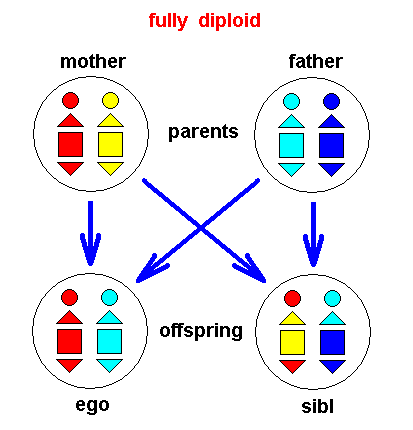
Figure 13 : Distribution of maternal and paternal genes in a fully diploid species.
"ego" is 'me', and "sibl" is 'my brother or sister'.
Coefficient of relationship between mother and daughter is equal to 1/2.
Coefficient of relationship between mother and son is equal to 1/2.
Coefficient of relationship between sisters is equal to 1/2.
Coefficient of relationship between brothers is equal to 1/2.
Hence the coefficient of relationship between the individual and its full sibling is 1/2. Therefore, according to Hamilton's argument, if a gene in the individual causes it to sacrifice its life [or time, or energy reserves] to save the lifes of [or cares for] more than two siblings, then the number of replicas of the gene present after the sacrifice is made, is greater than the number that would be present if the sacrifice had not been made. The sacrifice [as a genetically determined habit] is selectively advantageous. (In this instance the cost C is equal to 1, and the benefit B is equal to more than 2, so that the coefficient of relationship 1/2 is indeed greater than C / B.
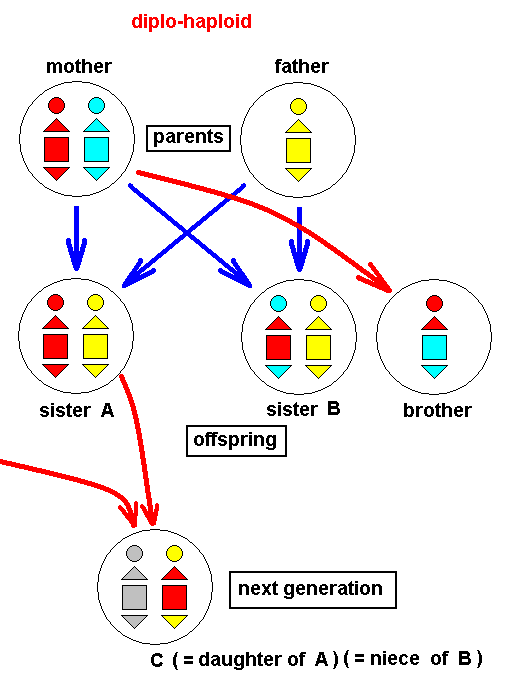
Figure 14 : Distribution of maternal and paternal genes in a diplo-haploid species. C is a daughter of A [being C's mother, father not drawn], and a niece of B.
Coefficient of relationship between mother and daughter is equal to 1/2.
Coefficient of relationship between sisters (A and B) is equal to 3/4.
Coefficient of relationship between an aunt (B) and a niece (C) is equal to 1/2.
To grasp the import of these numbers consider a species in which a female constructs and provisions a nest cell for each of her eggs and continues to lay eggs past the time when her first daughter reaches maturity. All fully social insects disply an overlap of this kind. The coefficients of relationship indicate that, other things being equal, the daughter will do the most to perpetuate her genes if instead of leaving [the parental nest] and provisioning nest cells containing her own daughters, she stays with her mother and provisions cells containing her sisters [daughters of her mother]. In this way the genetic makeup of the Hymenoptera [their haplo-diploidy] predisposes them to evolve a social system in which sterile female workers care for their full siblings.
(Continuing with the considerations of EVANS and EBERHARD on the evolution of social behavior in wasps :)
In all this we should evaluate the selective advantage of an atruistic gene (ore gene complex) such as those effecting individual females (possessing such a gene) to nurse their closest relatives only (sisters, coefficient of relationship being 3/4), because sometimes (that is, in certain different cases) nieces (coefficient of relationship being 1/2) are being nursed (See EVANS and EBERHARD, 1973, p. 204.
Notes om random genetic mutation and natural selection
On this website we propose a theory concerning the chief factors, and with them, the chief directions, of organic evolution. And in it we maintain that random genetic mutation paired with natural selection, held by Neo-Darwinian theory as the chief driving force of evolution, is not this driving force. It has not shaped evolution as we see it when comparing organisms with each other and inspecting fossils. This does not mean, however, that we completely deny its role in evolution. Genes do exist, and they are responsible for many (but definitely not all) traits in organisms, whether such traits are morphological, physiological, or behavioral. Natural selection definitely exists too. Further, different species of organisms have different genetic makeups. And when it is clear that one given species had evolved from another this had certainly involved a genetic change (or a consecutive series of such changes). The question, however, is how this genetic change -- a genetic mutation -- has come about : Was it the result of a random genetic change (or series of such changes), as is held by current Darwinism, or was it the result of a non-random genetic change (or series of such changes)? Well, in the light of the fact that random genetic changes have indeed occurred many times, and have brought about phenotypic changes in organisms, our theory should not exclude them, and our answer must be that both, random and non-random genetic mutations, play a role in evolution. But we still maintain that random genetic changes (paired with natural selection) only affect the periphery of evolution, such as the formation of races or of subspecies, and, generally, bring about only trivial changes. They are certainly not responsible for large-scale evolution, such as the origin of new strategies, new types, sophisticated adaptations, etc. For these, non-random genetic changes must be responsible. A random genetic mutation generally occurs in one, or perhaps a few, individuals of a given species (it is an individual event), so if such a mutation confers benificial features to its carrier, natural selection is needed to let such a mutated gene be widely distributed in the population, eventually completely replacing the original gene (initially still present in other individuals of the population, and in this way changing the species or splitting it up). On the other hand, natural selection is not needed for a beneficial non-random genetic mutation. Such a mutation is not accidental, not individual, but something programmatic or systematic, directly appearing at once in a great many individuals, individuals that is, now having a particular gene (or gene complex) changed. And the cause of such a non-random genetic change must -- according to our noëtic theory of evolution -- be sought for in the projection of some other ('new') organic strategy -- as such being a noëtic pattern -- from the Implicate Order into the Explicate Order.
Let us work out these ideas still further.
Random genetic mutation paired with natural selection is logically about number of offspring. And number of offspring is the direct result of biological fitness, that is, it reflects the degree of biological fitness (morphologically, physiologically, behaviorally, and ecologically). So in Darwinism, evolution from, say, A to B represents a path in which each step means for the organism to have obtained a higher degree of fitness (expressed in number of offspring). We can visualize such an evolutionary path as a journey through a "fitness landscape", where height (that is, the vertical dimension) expresses the degree of fitness of the relevant organisms and width (the horizontal dimension) their qualitative difference. Each accomplished evolutionary step in such a path means the arrival (of the organism) at some more elevated region of the landscape. And -- still in the context of standard Darwinism -- if A and B represent more or less fundamentally different taxonomic categories of organisms (for example A and B are species of different families), then B must represent a species having a significantly higher degree of fitness than A does, because every evolutionary step in the path from A to B has contributed to the fitness of the evolving organism. So if A and B are structurally far apart, meaning that in the fitness landscape they are separated from each other by a large distance, the path from A to B must go via a number of intermediate fitnesses. And because fitness can be achieved in many different ways we can expect that there are in fact many formally possible and different paths through the fitness landscape leading from A to B. The landscape between A and B can be expected to be rugged at some places, meaning that we may, while following some formally possible path from A to B, encounter local in-between "fitness peaks".
As has been said, natural selection logically is about number of offspring (reaching reproductive maturity), which is the expression of the degree of biological fitness (so biological fitness IS, in the context of natural selection, reproductive capacity). And evolution is, according to Darwinism, a blindfolded walk through the fitness landscape, blindfolded, because the genetic mutations that let the organism walk through the landscape are supposed to be random. And, still in line with Darwinism, the rule of conduct in such a walk reads : "only go up (ascend), or, at least never go down (descend)", that is, only move from less fit to more fit. And this is completely logical, because a given organism to be more fit here means that it has a greater reproductive capacity, resulting in the gene, responsible for this greater fitness, becoming more numerous in the population, finally replacing the old gene completely. And because "more numerous" is equivalent to "more fit", the 'rule of conduct' for a traveller in the landscape is indeed "only go up". So when a hill is encountered (the path already being on its slope) then the traveller should climb up on it.
If we now consider again the distantly related organisms (=organismic types, or species) A and B, and the fact that along the evolutionary path leading from A to B there must be many stations in between, and, especially, the fact that many formally possible paths have local fitness peaks on their way, following the Darwinian rule of "going up only" leads to the fact that the evolving organismic type or species will eventually get evolutionarily stuck on top of one or another such a fitness peak (where all remaining options lead to "going down" (descending) and are therefore 'forbidden') situated between A and B in the fitness landscape. And thus, it will often happen, that, starting from A, and following one of the formally possible paths to B, B will never be reached whenever some in-between hill or peak is encountered and climbed. B will only be reached when such in-between hills (which are in fact obstacles to an evolution from A to B) are deliberately avoided. And because an evolutionary path through the fitness landscape consists, at least chiefly, of consecutive genetic mutations of the (relevant) genome, these mutations cannot be all of them random genetic mutations (because then there is a great chance of getting stuck on some in-between fitness hill top), but must largely be non-random genetic changes. Only then B can (in all cases) finally be reached.
And it is our theory of the Implicate and Explicate Orders -- the noëtic and physical orders of Reality -- that is 'providing' such non-random genetic mutations (without resorting to 'theories of design' that presuppose some 'designer' having been at work in forging organisms) : Upon "projection" -- from the Implicate into the Explicate Order -- of a given "strategy" (this projection resulting from a noëtic pattern's innate striving toward ontological completion) organisms with different genomes will, one after the other, appear in the Explicate Order in the appropriate ecological context. And a "strategy" is a description of how, for a given initially mere immaterial pattern in the Implicate Order to exist and persist in the Explicate Order (and so obtaining ontological completion), where this immaterial pattern IS the strategy.
This change of genome (which we see as the successive appearance of organisms with different genomes) in most individuals of the (given) species is then explained by Darwinism as having been accomplished by random genetic mutation(s) and natural selection, while in fact it has come about as a non-random genetic mutation (or a series of such mutations) as a result of projection from the Implicate Order.
So non-random genetic mutation (along with other non-random changes) has a place in our noëtic theory of evolution. In this theory, as has been expounded, it is the noëtic trajectory, having its course in the Implicate Order, that determines long-term organic evolution. In fact this trajectory reflects the structure of the Implicate Order by connecting noëtic patterns with each other in so far as they can noëtically be derived from each other. The derivability and its direction (and thus the noëtic trajectory) is determined by increasing intrinsic or internal noëtic stability of the noëtic patterns (that is, of one pattern as compared to another). The derivation goes from less internally stable to more internally stable patterns. And, as has been explained, this internal stability is in turn determined by the degree of integration of the parts of such a noëtic pattern, that is, the degree of wholeness of such a pattern. It is further assumed that the patterns that are successively (not understood in a temporal sense but in the sense of derivations) visited by the noëtic trajectory are projected into the Explicate Order, appearing there materially and successively (in a temporal sense), and obtaining in this way ontological completion (the pure Form is received by Prime Matter, or, said differently, Prime Matter -- absent in the Implicate Order -- is 'informed' by the noëtic pattern being projected into the Explicate Order). But, as has also been said earlier, not all noëtic patterns can be so projected, because many of them are qualitatively incompatible with the fundamental structure of, and conditions in, the Explicate Order. And this holds for most of the complex noëtic patterns. Some of them, however, are themselves descriptions of one or another strategy to exist and persist in the Explicate Order. And they will successively be projected into this Order according to the course of the noëtic trajectory in the Implicate Order. And indeed, they successively appear there (that is, in the Explicate Order) as organisms. The progression of the noëtic trajectory in the Implicate Order from in a lesser degree internally integrated noëtic patterns to in a higher degree internally integrated noëtic patterns is in the Explicate Order reflected by the fact of evolution of organisms that become in a higher and higher degree internally integrated. This higher internal integration of an organismic species or type does not necessarily mean that it is more ecologically successful, but that it is just different, it is the expression of just another strategy for a noëtic pattern to exist and persist in the Explicate Order.
Accordingly, in this scenario it is non-random genetic (and other) changes that form the core of organic evolution. Random genetic changes paired with natural selection are effective only at the periphery of evolution, even when they occur all the time. This is because a long-term evolution, leading to some complicated and sophisticated adaptation (morphologically or behaviorally), or leading to some new organismic type, or just leading to the continuous development of a single feature, cannot be accomplished by a series of successive random genetic mutations (followed by natural selection), because such a series, as a result of the very randomness of its members, will never be a straight series neatly leading to a particular result. And, as has been said, such a result often is some complex adaptation, or new type. And a particularly significant case in this respect is the origin of sociality in insects (where it is developed in its highest degree). Here especially there are many obstacles to explain it along standard Darwinian lines.
(End of notes on random genetic mutation and natural selection)
With all this we have come to an end of our exposition of the Social Phase in wasp evolution.
e-mail :
 ( Please write in ' Subject ' entry : ' METAPHYSICS ', in order for me to be able to distinguish your mail from spam )
( Please write in ' Subject ' entry : ' METAPHYSICS ', in order for me to be able to distinguish your mail from spam )
To continue click HERE for the further study of Organic Evolution, Part LV.
Back to Evolutionary Part XVII
Back to Evolutionary Part XVIII
Back to Evolutionary Part XXII
Back to Evolutionary Part XXIII
Back to Evolutionary Part XXIV
Back to Evolutionary Part XXV-A
Back to Evolutionary Part XXV-B
Back to Evolutionary Part XXV-C
Back to Evolutionary Part XXVI
Back to Evolutionary Part XXVII
Back to Evolutionary Part XXVIII
Back to Evolutionary Part XXVIII-A
Back to Evolutionary Part XXIX
Back to Evolutionary Part XXXI
Back to Evolutionary Part XXXII
Back to Evolutionary Part XXXIII
Back to Evolutionary Part XXXIV
Back to Evolutionary Part XXXV
Back to Evolutionary Part XXXVI
Back to Evolutionary Part XXXVII
Back to Evolutionary Part XXXVIII
Back to Evolutionary Part XXXIX
Back to Evolutionary Part XLII
Back to Evolutionary Part XLIII
Back to Evolutionary Part XLIV
Back to Evolutionary Part XLVI
Back to Evolutionary Part XLVII
Back to Evolutionary Part XLVIII
Back to Evolutionary Part XLIX
Back to Evolutionary Part LIII